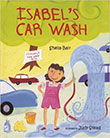Isabel's Car Wash Q&A

Use these questions with children 8 to 11 years old to discuss the following economic concepts in Isabel's Car Wash: dividend, entrepreneur, investor, profit, revenue, risk, and tax.
View all of our Parent Q&A resources.
Teachers: View the lesson plan using Isabel's Car Wash.
Book written by Sheila Bair (ISBN: 978-0-8075-3653-7).
Questions:
1. Entrepreneurs are people who take risks—the chance of loss—to develop new products or start new businesses. Why did Isabel want to become an entrepreneur?
Isabel wanted a Nelly Longhair doll but didn't have enough money to buy it. She decided to earn the money by starting her own car wash.
2. Investors are people who lend other people money to start a business or help a business grow. How did Isabel convince her friends to become investors in her business?
Isabel said she thought she could pay her friends back plus give them extra money. (This extra money is called a dividend for the investors.) She assured them that she knew how to wash cars and that she would have good business because cars were muddy from all the rain. She said she would keep half the money she made and give the other half to them.
3. What did Isabel say when Natalie asked why Isabel should you get more money? Do you agree with Isabel? Why or why not?
Isabel said, "Because it's my idea, and I will do all the work." Answers will vary depending on whether the child agrees or not.
4. What risk did Lin point out about lending Isabel money? Was it potentially true?
Lin said, "But if not enough people come to your car wash, we could lose our money." Yes, the investors did take the risk of losing their money.
5. How did Isabel prepare to start her business?
After borrowing money from her friends, Isabel bought soap and shammies, hooked up the hose, got clean rags and a bucket, and nailed a big sign to the tree in her front yard.
6. The money that Isabel earned is called revenue. How much revenue did she earn?
$20
7. Profit is the amount of money an entrepreneur has after paying the costs of doing business. The costs for Isabel were her loans. How much were her costs? How much was her profit?
Costs: $5, Profit: $15
8. What did Isabel do with her profit?
She kept $10 and used the other $5 to pay her investors some extra money—a dividend for taking a risk and investing in her business.
9. Was Isabel a successful entrepreneur? Why?
Yes, Isabel was successful because she washed cars and a few other things, which earned her enough money to buy the doll and repay her investors plus give them a dividend.
10. A tax is money people and businesses are required to pay to the government. One type of tax is a sales tax—a tax paid on the amount of a purchase. How much money did Isabel pay for the doll, including the sales tax?
She paid $10.50: $10 for the doll plus 50 cents for the sales tax.
11. If you could become an entrepreneur with your own business, what type of business would you start? What would you do to make it successful?
Answers will vary but may include the following: develop a business plan, ask investors to lend money to help you get started, and work hard to earn a profit.
---
If you have difficulty accessing this content due to a disability, please contact us at 314-444-4662 or economiceducation@stls.frb.org.

